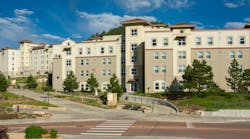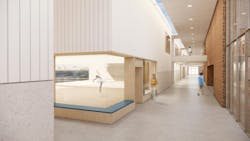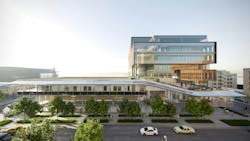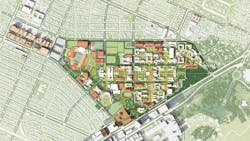Higher education strategies for recruiting and retaining students and staff
Today’s universities are becoming sustainable, personalized, and more flexible than ever. From emerging programs related to AI and Esports to a push for diverse student housing, there are multiple strategies in place to recruit students and staff.
The primary challenge for everyone working in the sector continues to be funding. Government resources have dried up quite a bit, and we’re seeing a shift toward private funding and heavily donor-driven projects. While firms like Helix Architecture + Design have a more positive outlook now than they did a few months ago, the challenge of staff and student recruitment remains top-of-mind for many.
There are several factors that go into the recruitment and retention of university staff, faculty, and students. Is it all in student housing? Master planning? Faculty resources? BD+C sat down with some higher education experts to find out what makes a university really stick out in 2025.
Student Housing
Housing is one of the biggest attractors for students when it comes to choosing a university. While well-designed housing facilities help both attract and retain students, they also act as a necessary revenue generator for the university.
Helix Architecture + Design has implemented a successful strategy across its student housing portfolio—one that offers different levels of housing. First-year students may live in traditional double rooms to prioritize making friends, second-year students can upgrade to semi-suites to live with up to four friends, and upper-level students desire more privacy in apartment-style housing equipped with kitchens.
Helix calls this the “ladder effect” where all these styles of housing exist in the same building. The goal is to have a place where mentorship may take hold; upper-level students can help the ones literally below them.
Meanwhile, off-campus housing remains a viable recruitment tool for students as well. This is where firms like Stantec see the post-Covid generation of students desire alternative ways of living. Not everyone is particularly excited about living in traditional dormitories.
“Modern, amenable facilities with a variety of unit types and price points really stand out to students (and their parents) as they visit different campuses and weigh their post-secondary education decisions,” says Léo Lejeune, Education Sector Leader, Stantec.
The Campus Experience
The identity of the university and its physical campus plays an important role in attracting and retaining students, faculty, and staff as well.
“Imagining how one sees themself in a setting that appeals to their learning, research, work, and social aspirations is key,” says Mary Anne Ocampo, Principal and Urban Designer, Sasaki.
Ocampo believes that the overall campus experience—from the initial campus visit to daily life during the academic year—is shaped by architecture, landscape, public spaces, and campus culture.
At universities today, there is an emphasis on campus experience in ways of accessibility, health and wellness, and social engagement. Claudia Cusumano, Principal of Kenneth Park Architects, suggests that the campus experience is not designed in a generic approach, but rather bespoke to the campus, context, and community—as well as specific to each building type.
For a business school, does it foster innovation? Does it invite those outside of the business school in for cross collaborative work? For a lab, can you see the science on display? Is it a high-quality research facility? For the faculty, does the architecture aid in building community amongst faculty? These are the things that will stand out as attractors.
Part of the campus experience is how well the university provides the tools necessary for professors to teach their crafts. For faculty recruitment and retention, having less siloing can result in better facilities than individual professors or departments might otherwise enjoy.
Clay Phillips, AIA, Principal and Higher Education Market Leader, Helix Architecture + Design, uses an example at the Performing Arts Center for University of Missouri-Kansas City (UMKC) where the Dean wanted an interdisciplinary environment where students cross-collaborate and create new art. Helix designed an acting studio next to a dance room adjacent to a music practice room—this allows the students to see and hear each other every day.
Another project from Helix combines curricula for Wichita State University, University of Kansas Medical Center, and WSU Tech: WSU’s College of Health Professions and Speech-Language-Hearing Clinic, WSU Tech’s Health Professions program, and the Wichita campuses of KU School of Medicine and KU School of Pharmacy. Tomorrow’s doctors, nurses, physical therapists, pharmacists, and medical technicians will learn alongside each other.
Master Planning
This folds into the master planning of the campus. Schools are looking to create interdisciplinary collaboration centers where certain studies common to different disciplines can be taught, and where joint academic and research projects can be developed. The different expressions of these trends have resulted in new building typologies.
We’ve seen it time and time again—flexible buildings are making waves at universities as they check all the boxes. These buildings “attract students, increase interpersonal engagement, and make the most of pre-existing inventory and land,” as reported by BD+C in a 2024 article.
However, master planning goes beyond the flexible. One international campus in Peru saw enrollment grow 30% in two years due in part to significant changes in master planning. The University of Lima’s first ever student recreation and wellness center was built as a new campus crossroad. Sasaki developed the master plan for the whole campus and built three buildings and a series of common open spaces. The impact of the new infrastructure centered around student life grew the population of the university from an initial population of 18,000 students to its current cap at 30,000.
Firms like Sasaki are also seeing more collaboration between universities and municipalities, leading to planning and urban design solutions that offer shared benefits. At Rice University, the Sasaki's Campus Framework Plan reflects the aspirations of the institution’s role in Houston, the energy capital of the U.S. The plan supports ambitious decarbonization goals, the development of interdisciplinary research facilities focused on sustainability innovation, and targeted investment in energy infrastructure.
In fact, sustainability is a big driver for today's students and staff.
Personalization and Flexibility
Rich Jacobson, Chief Operating Officer and Executive Vice President, Kraus-Anderson Construction Company is seeing a shift towards a more sustainable and efficient campus environment which includes investing in energy-efficient technologies, retrofitting existing buildings, and incorporating sustainable materials in new construction.
“What we are seeing in higher education building are projects trending toward flexible, multiuse and close collaboration with industry, especially major economic drivers in the region,” says Jacobson.
In North Dakota, the institutions Kraus-Anderson is working with are addressing increasing enrollment and added programs, staffing challenges, and finding space for student housing as well as programming. Funding and budgetary constraints are also influencing decisions, with institutions focusing on maximizing resources and exploring innovative solutions. While master planning plays an important role in construction planning, flexible spaces are a key design driver. Campuses are prioritizing optimizing existing spaces and leveraging technology to improve overall operations and enhance student experience.
When it comes to recruiting and retaining students and staff, there are a lot of moving pieces. As we can see here, there may not be a one-size-fits-all solution, as several factors from master planning to personalization should be considered.
About the Author

Quinn Purcell
Quinn Purcell is the Managing Editor for Building Design+Construction. He is a graduate of Idaho State University with a Bachelor of Arts in Communication, and an emphasis in Multiplatform Journalism. He specializes in video, photography, copywriting, feature writing, and graphic design.




